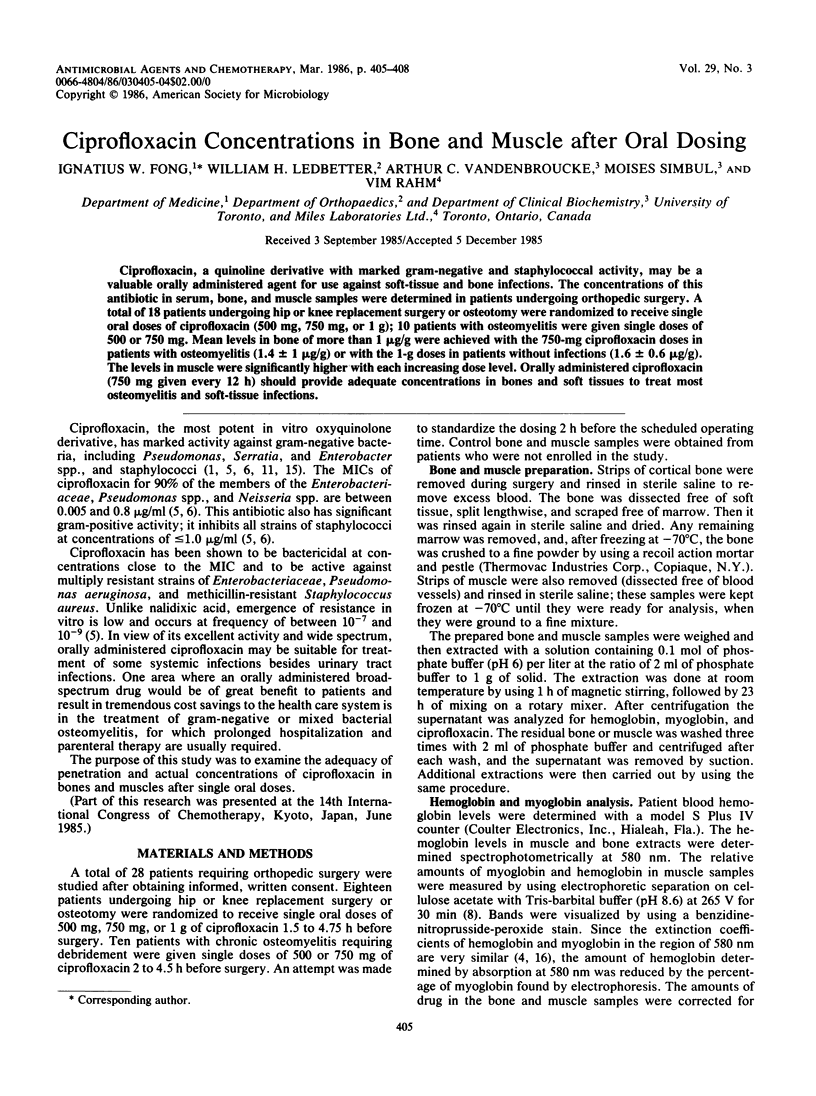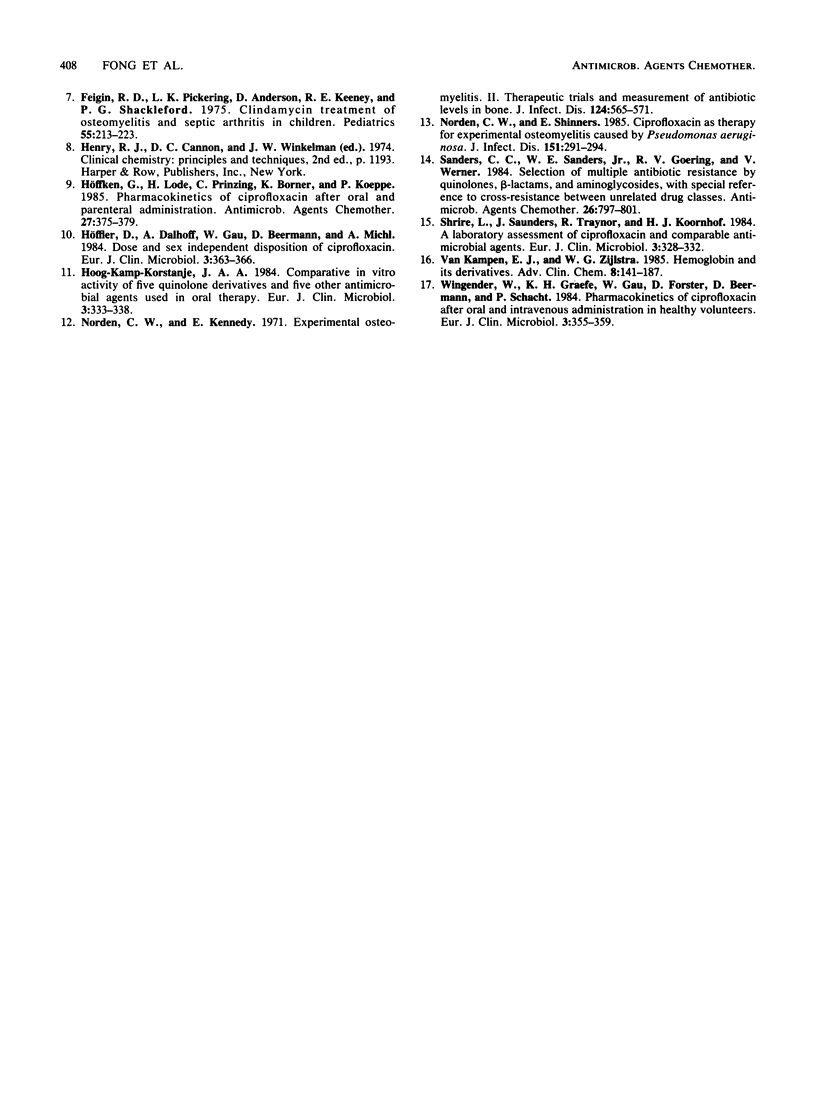Abstract
Ciprofloxacin, a quinoline derivative with marked gram-negative and staphylococcal activity, may be a valuable orally administered agent for use against soft-tissue and bone infections. The concentrations of this antibiotic in serum, bone, and muscle samples were determined in patients undergoing orthopedic surgery. A total of 18 patients undergoing hip or knee replacement surgery or osteotomy were randomized to receive single oral doses of ciprofloxacin (500 mg, 750 mg, or 1 g); 10 patients with osteomyelitis were given single doses of 500 or 750 mg. Mean levels in bone of more than 1 microgram/g were achieved with the 750-mg ciprofloxacin doses in patients with osteomyelitis (1.4 +/- 1 microgram/g) or with the 1-g doses in patients without infections (1.6 +/- 0.6 microgram/g). The levels in muscle were significantly higher with each increasing dose level. Orally administered ciprofloxacin (750 mg given every 12 h) should provide adequate concentrations in bones and soft tissues to treat most osteomyelitis and soft-tissue infections.
Full text
PDF



Selected References
These references are in PubMed. This may not be the complete list of references from this article.
- Barry A. L., Jones R. N., Thornsberry C., Ayers L. W., Gerlach E. H., Sommers H. M. Antibacterial activities of ciprofloxacin, norfloxacin, oxolinic acid, cinoxacin, and nalidixic acid. Antimicrob Agents Chemother. 1984 May;25(5):633–637. doi: 10.1128/aac.25.5.633. [DOI] [PMC free article] [PubMed] [Google Scholar]
- Bell S. M. Further observations on the value of oral penicillins in chronic staphylococcal osteomyelitis. Med J Aust. 1976 Oct 16;2(16):591–593. doi: 10.5694/j.1326-5377.1976.tb115265.x. [DOI] [PubMed] [Google Scholar]
- Blockey N. J., McAllister T. A. Antibiotics in acute osteomyelitis in children. J Bone Joint Surg Br. 1972 May;54(2):299–309. [PubMed] [Google Scholar]
- Chin N. X., Neu H. C. Ciprofloxacin, a quinolone carboxylic acid compound active against aerobic and anaerobic bacteria. Antimicrob Agents Chemother. 1984 Mar;25(3):319–326. doi: 10.1128/aac.25.3.319. [DOI] [PMC free article] [PubMed] [Google Scholar]
- Eliopoulos G. M., Gardella A., Moellering R. C., Jr In vitro activity of ciprofloxacin, a new carboxyquinoline antimicrobial agent. Antimicrob Agents Chemother. 1984 Mar;25(3):331–335. doi: 10.1128/aac.25.3.331. [DOI] [PMC free article] [PubMed] [Google Scholar]
- Feigin R. D., Pickering L. K., Anderson D., Keeney R. E., Shackleford P. G. Clindamycin treatment of osteomyelitis and septic arthritis in children. Pediatrics. 1975 Feb;55(2):213–223. [PubMed] [Google Scholar]
- Hoogkamp-Korstanje J. A. Comparative in vitro activity of five quinoline derivatives and five other antimicrobial agents used in oral therapy. Eur J Clin Microbiol. 1984 Aug;3(4):333–338. doi: 10.1007/BF01977489. [DOI] [PubMed] [Google Scholar]
- Höffken G., Lode H., Prinzing C., Borner K., Koeppe P. Pharmacokinetics of ciprofloxacin after oral and parenteral administration. Antimicrob Agents Chemother. 1985 Mar;27(3):375–379. doi: 10.1128/aac.27.3.375. [DOI] [PMC free article] [PubMed] [Google Scholar]
- Höffler D., Dalhoff A., Gau W., Beermann D., Michl A. Dose- and sex-independent disposition of ciprofloxacin. Eur J Clin Microbiol. 1984 Aug;3(4):363–366. doi: 10.1007/BF01977496. [DOI] [PubMed] [Google Scholar]
- Norden C. W. Experimental osteomyelitis. II. Therapeutic trials and measurement of antibiotic levels in bone. J Infect Dis. 1971 Dec;124(6):565–571. doi: 10.1093/infdis/124.6.565. [DOI] [PubMed] [Google Scholar]
- Norden C. W., Shinners E. Ciprofloxacin as therapy for experimental osteomyelitis caused by Pseudomonas aeruginosa. J Infect Dis. 1985 Feb;151(2):291–294. doi: 10.1093/infdis/151.2.291. [DOI] [PubMed] [Google Scholar]
- Sanders C. C., Sanders W. E., Jr, Goering R. V., Werner V. Selection of multiple antibiotic resistance by quinolones, beta-lactams, and aminoglycosides with special reference to cross-resistance between unrelated drug classes. Antimicrob Agents Chemother. 1984 Dec;26(6):797–801. doi: 10.1128/aac.26.6.797. [DOI] [PMC free article] [PubMed] [Google Scholar]
- Shrire L., Saunders J., Traynor R., Koornhof H. J. A laboratory assessment of ciprofloxacin and comparable antimicrobial agents. Eur J Clin Microbiol. 1984 Aug;3(4):328–332. doi: 10.1007/BF01977488. [DOI] [PubMed] [Google Scholar]
- Van Kampen E. J., Zijlstra W. G. Determination of hemoglobin and its derivatives. Adv Clin Chem. 1965;8:141–187. doi: 10.1016/s0065-2423(08)60414-x. [DOI] [PubMed] [Google Scholar]
- Wingender W., Graefe K. H., Gau W., Förster D., Beermann D., Schacht P. Pharmacokinetics of ciprofloxacin after oral and intravenous administration in healthy volunteers. Eur J Clin Microbiol. 1984 Aug;3(4):355–359. doi: 10.1007/BF01977494. [DOI] [PubMed] [Google Scholar]


